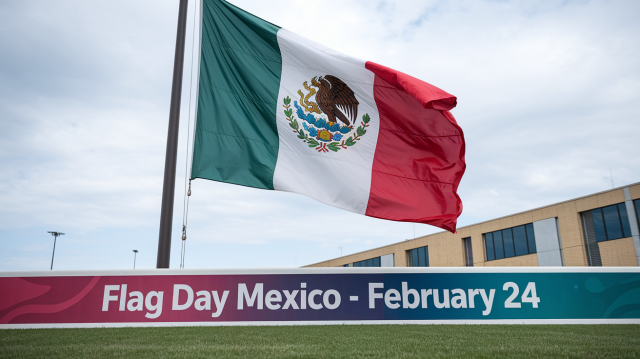Flag Day in Mexico, or Día de la Bandera, is celebrated annually on February 24 to honor the Mexican flag as a symbol of national identity, unity, and pride. This day commemorates the rich history and cultural significance of the flag, which represents the values of hope, purity, and the sacrifices made for independence. It is a time for Mexicans to reflect on their heritage and celebrate their shared patriotism.
Why Is It Celebrated?
Flag Day is celebrated to pay tribute to one of Mexico’s most important national symbols. The flag’s colors—green for hope, white for unity, and red for the blood of heroes—carry profound meaning tied to Mexico’s history and independence. The date, February 24, marks the signing of the Iguala Plan in 1821, which laid the foundation for Mexico’s independence from Spain.
Cultural Significance
The Mexican flag is deeply rooted in the country’s history and mythology. Its emblem—a golden eagle perched on a cactus while devouring a snake—stems from an Aztec legend about the founding of Tenochtitlán, now Mexico City. This holiday reflects Mexico’s cultural traditions and national pride.
Unique Traditions:
- Flag Ceremonies: Schools and public institutions hold ceremonies where students pledge allegiance to the flag and sing El Toque de Bandera, a short anthem in its honor.
- Parades and Festivals: Cities host parades featuring colorful floats, traditional music, and dance performances.
- Historical Education: Museums and cultural centers organize exhibitions about the history of the flag and its evolution.
Social Impact
Flag Day fosters unity by bringing communities together to celebrate their shared heritage. Public events, school activities, and civic ceremonies strengthen bonds among citizens while promoting national pride.
The Importance of It
This day underscores the importance of remembering Mexico’s struggles for independence and celebrating its identity. It inspires reflection on themes such as freedom, unity, and cultural pride while encouraging citizens to honor their history.
Educational Value
Flag Day provides an opportunity to learn about Mexico’s history through school programs, museum exhibits, and public lectures. It highlights key moments like the War of Independence (1810–1821) and teaches younger generations about the values symbolized by the flag.
Emotional Connection
The celebration fosters emotional bonds by connecting Mexicans to their past through stories of heroism and sacrifice. The flag serves as a unifying emblem that resonates deeply with citizens both within Mexico and abroad.
The Origin of It
The origins of Flag Day trace back to 1935 when Benito Ramírez, an employee at the Bank of Mexico, began commemorating the flag on February 24. In 1940, President Lázaro Cárdenas officially established Día de la Bandera as a national holiday. The date was chosen to honor the Iguala Plan’s signing in 1821.
Historical Events:
- 1821 Iguala Plan: Established principles of independence, unity, and religion symbolized by the flag’s colors.
- Adoption of Current Flag: The modern design was officially adopted in 1968 but retains elements from earlier versions dating back to independence.
Evolution Over Time:
While initially focused on civic ceremonies, Flag Day has grown into a nationwide celebration with parades, cultural events, and educational activities that engage all generations.
How to Celebrate
Here are meaningful ways to observe Flag Day in Mexico:
- Attend or participate in flag ceremonies at schools or public institutions.
- Watch parades featuring traditional music and dance.
- Visit museums or historical sites that showcase Mexican heritage.
- Host gatherings with friends or family to celebrate national pride.
- Share reflections on social media using relevant hashtags like #DíaDeLaBandera.
Conclusion
Flag Day in Mexico is a powerful reminder of the country’s rich history and enduring values. By celebrating this occasion, Mexicans honor their past while embracing unity and pride in their national identity. Whether through traditional ceremonies or modern festivities, Día de la Bandera continues to inspire patriotism across generations.












